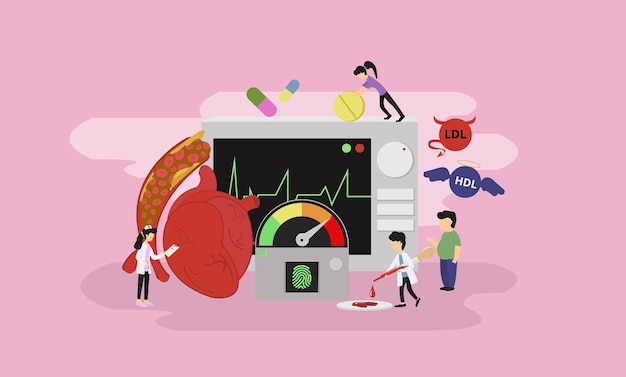
If you’re 20 or older, your doctor has likely suggested getting your cholesterol checked through a blood test. But when you get your results, all the numbers, acronyms, and ratios can feel overwhelming. What do they mean? How does this information affect you, and what can you do about it? Let’s break it down.
### What Exactly Is Cholesterol?
Cholesterol is a waxy substance your body needs to build cells, and your liver produces all the cholesterol your body requires. However, too much cholesterol isn’t a good thing—it can negatively impact your heart health.
When excess cholesterol accumulates in your blood vessels, they can become narrower and less flexible. This increases the risk of a blood clot forming, which might lead to a heart attack or stroke. Having too much “bad” cholesterol or not enough “good” cholesterol can amplify these risks.
Certain foods—like those high in saturated fats, trans fats, or oils such as palm or coconut oil—prompt your liver to produce more cholesterol than usual, potentially pushing you into unhealthy cholesterol levels. Foods like meat, poultry, and full-fat dairy products also contain dietary cholesterol, which can contribute to overall levels.
While people often think low cholesterol is good and high cholesterol is bad, it’s actually a bit more complex. Understanding the different types of cholesterol and what your lab results mean can help you take practical steps to maintain or improve your cardiovascular health.
### Types of Cholesterol: LDL and HDL
When you hear about “good” and “bad” cholesterol, it refers to two types of lipoproteins: low-density lipoprotein (LDL) and high-density lipoprotein (HDL).
– **LDL (Bad Cholesterol):** This type raises your risk of heart disease by promoting the buildup of fatty deposits in your arteries.
– **HDL (Good Cholesterol):** This type helps remove LDL from your bloodstream, lowering your heart disease risk.
### What Are Triglycerides?
Triglycerides are a form of fat that your body uses to store energy. They’re the most common type of fat in your system. About one in four adults in the U.S. has high triglyceride levels. When your triglycerides are high—especially when combined with high LDL and low HDL levels—you face an elevated risk of plaque buildup in your arteries, which can lead to heart disease.
### Ideal Cholesterol Levels
Your doctor will likely want your cholesterol levels to fall within these recommended ranges:
– **Total Cholesterol:** Less than 200 mg/dL (calculated as HDL + LDL + 20% of triglycerides)
– **LDL Cholesterol:** Less than 100 mg/dL
– **HDL Cholesterol:** Greater than 60 mg/dL
– **Triglycerides:** Less than 150 mg/dL
Another factor to consider is your cholesterol ratio, which is your total cholesterol divided by your HDL cholesterol. A lower ratio means a lower risk of heart disease. Doctors generally recommend a ratio under 5, with below 3.5 being excellent.
### When Should You Test Your Cholesterol?
The American Heart Association advises adults aged 20 and older to have their cholesterol checked every four to six years, as long as they’re at low risk for heart attack or stroke. Once you hit 40, your doctor will likely assess your risk and adjust the testing frequency accordingly.
### Lifestyle Changes to Improve Cholesterol
Making small, manageable lifestyle changes can positively impact your cholesterol and lower your risk of heart disease. Here’s what you can do:
– **Eat smarter:** Focus on foods that are low in fat and refined carbohydrates.
– **Include healthy fats:** Opt for fish rich in omega-3 fatty acids, such as salmon, tuna, and halibut.
– **Stay active:** Get around 30 minutes of exercise most days of the week.
– **Maintain a healthy weight:** Keep your body weight within a healthy range.
– **Avoid smoking:** Quitting smoking can dramatically improve your HDL levels.
– **Limit alcohol:** Stick to no more than one drink per day for women and two drinks per day for men.
– **Take prescribed meds:** If you have conditions like high blood pressure, be consistent with your medication.
### When Is Medication Necessary?
In some cases, lifestyle changes alone may not be enough to bring your cholesterol to healthy levels. Your doctor might recommend statins—medications that help lower LDL cholesterol.
During your cholesterol test, your doctor can also estimate your 10-year risk of heart attack or stroke. If your risk is high, statins may be prescribed to help reduce it. These medications can lower your chances of cardiovascular issues by 20–25%, with greater benefits if your risk level is higher.
### Bottom Line
Your cholesterol levels—covering total cholesterol, LDL, HDL, and triglycerides—are essential markers for understanding your heart health. Knowing your numbers and what they signify can empower you to take steps toward improving them and protecting your heart.
By staying informed and working with your doctor, you can create a personalized plan for keeping your cholesterol in check and supporting long-term health.